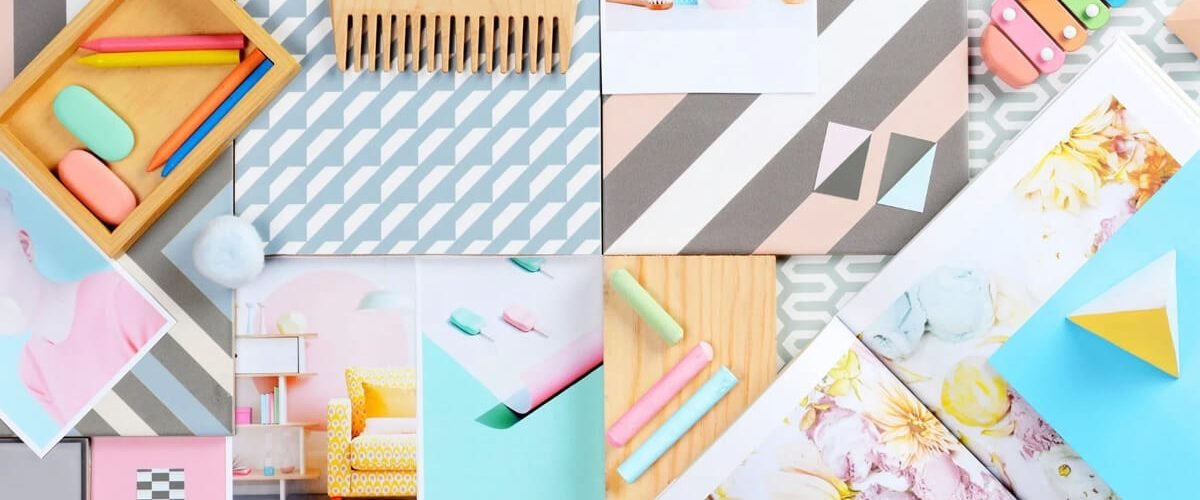Knowing the simple art of creating mood boards is essential for creative design professionals. Effective visual communication has always been a demanding task. Interior designers, photographers, filmmakers, and illustrators require a medium to organize and develop initial thoughts into complete projects. Moreover, they need to visually present the crux of an idea to clients in a simple, effective manner before starting projects. Mood boards serve these very purposes.
Mood boards are a simple collection of pictures or graphics to portray a whole idea. They might serve as portfolios for creatives to showcase their work to clients. They can also help artists during abstract thought development stages and organize them into complete projects. In addition to this, mood boards enhance readers’ visual experience for websites and magazines. Thus, mood boards rightly deserve the alternative name: inspirational boards.

Creating digital mood boards is no longer a problem; all you need is to find a convenient platform. There might be a lot of options for graphic design and communication software, but finding user-friendly and suitable software for your task might be challenging. In this regard, we’ve got you covered. After thorough research and analysis, we bring you the top digital software in the market. Some of the best powered software to create mood boards are:
- Foyr Neo
- Infernia
- Sketch up
- Autodesk AutoCAD LT
Foyr Neo
Foyr Neo is one of the most reliable and trusted solutions for most design-related problems. It contains everything that you need on one page. Most importantly, you don’t have to learn how to create mood boards because of intuitive designer tools; it has a user-friendly interface that displays all of them directly. Foyr Neo renders images in 4k quality, due to which the projects have a high-end finish.
One of the best qualities of Foyer Neo is how the process of creation, design, and rendering of mood boards can occur all at one place. In addition, it has an excellent web interface and downloadable software, providing great freedom of use.
Moreover, it offers a massive collection of templates and designs. You can not only remodel them but also render them. So, you can drag and drop these products into your design and further customize them. The Premium version of this software starts from as low as $49 per month. However, with a 14-day trial period, you can test the interface for its compatibility with your project
Infernia
It is a cloud storage-based design software used mainly for architecture-related projects and interior design. Apart from the design, it offers designers to communicate and collaborate with other designers. However, it is more of a Building Information Modelling Software restricted to houses and apartments. It also provides a 14-day free trial starting from $50 per month.
Sketch up:
Sketchup is a 3D model creator for creating 2-D models and converting them to 3-D. It is a platform that enables interior designers to customize models by adding layers and styles. Included with a web interface, desktop software, and unlimited cloud storage, Sketch up offers a free version, but value-added services are at the cost of $100 per month.
Autodesk AutoCAD LT:
Starting from $200 per month, it is also a popular software among interior and graphic design professionals. Browser-based and with an intuitive interface, Autodesk is a very feasible solution for interior design. It allows users to create detailed 2-D designs that can be later converted into 3-D.
Simple Tips and Tricks on How to Create Mood Boards
Learning how to create mood boards effectively might seem a mammoth task that requires a lot of time and expertise, but this is not the case. All you need are simple tips and tricks from experts gathered for you.
Portray Brand Image
Most mood boards might represent a particular brand or a product. So, the theme of your mood board must be entirely in line with the brand. Mood boards portray the complete brand image even for a single product. You can do this by using theme-based colors, fonts, and icons. The choice might vary from brand to brand or product to product.
Parallel Concepts
You can use two or more parallel concepts in a single mood board for the same project. This provides greater freedom to clients, allowing them to compare and choose with ease. Creatives widely use this technique because of its effectiveness.
Limitless approach
While creating a mood board, don’t limit yourself to specific items or stuff that you have to add. As long as it portrays the idea and mood board does not seem jumbled up with stuff.
Core Elements
While designing a mood board of specific user interfaces for corporate clients, make sure you cover all core elements. However, you should organize these elements in a way that ensures a great visual experience
Experiment
Don’t shy away from experimenting with different colors, fonts, and icons to determine which goes best with your theme. Mix and match various pictures and change orientations to find out the best match.
Conclusion
By now, we are well aware that creating mood boards is not as difficult as it seems. You continue to improve with practice and gain expertise with experience. However, you must choose suitable software that provides the most options at the best price to create mood boards.
Out of all four options mentioned in the article, Foyr Neo stands out for multiple reasons. Firstly, it is cost-effective and provides a free 14-day trial for creatives to check if it’s suitable. Moreover, the free templates and high-quality image finishing make Foyer Neo a reliable designer option. With software like Foyr Neo and the simple tips and tricks mentioned above, anyone can design visually aesthetic mood boards.





